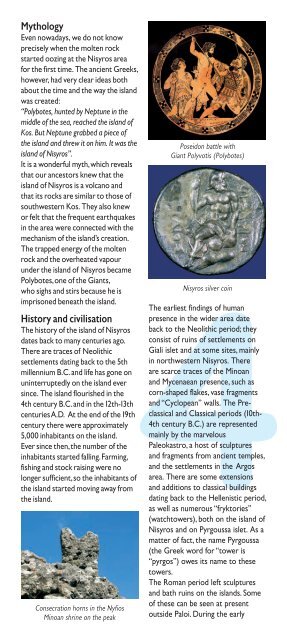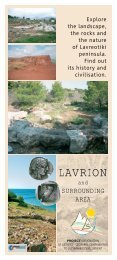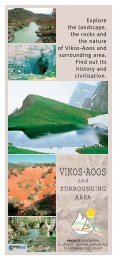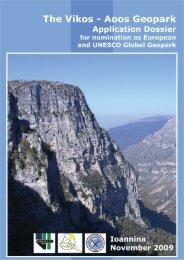NISYROS - Welcome to the Greek Geological Institute Web page ...
NISYROS - Welcome to the Greek Geological Institute Web page ...
NISYROS - Welcome to the Greek Geological Institute Web page ...
Create successful ePaper yourself
Turn your PDF publications into a flip-book with our unique Google optimized e-Paper software.
Mythology<br />
Even nowadays, we do not know<br />
precisely when <strong>the</strong> molten rock<br />
started oozing at <strong>the</strong> Nisyros area<br />
for <strong>the</strong> first time. The ancient <strong>Greek</strong>s,<br />
however, had very clear ideas both<br />
about <strong>the</strong> time and <strong>the</strong> way <strong>the</strong> island<br />
was created:<br />
“Polybotes, hunted by Neptune in <strong>the</strong><br />
middle of <strong>the</strong> sea, reached <strong>the</strong> island of<br />
Kos. But Neptune grabbed a piece of<br />
<strong>the</strong> island and threw it on him. It was <strong>the</strong><br />
island of Nisyros”.<br />
It is a wonderful myth, which reveals<br />
that our ances<strong>to</strong>rs knew that <strong>the</strong><br />
island of Nisyros is a volcano and<br />
that its rocks are similar <strong>to</strong> those of<br />
southwestern Kos. They also knew<br />
or felt that <strong>the</strong> frequent earthquakes<br />
in <strong>the</strong> area were connected with <strong>the</strong><br />
mechanism of <strong>the</strong> island’s creation.<br />
The trapped energy of <strong>the</strong> molten<br />
rock and <strong>the</strong> overheated vapour<br />
under <strong>the</strong> island of Nisyros became<br />
Polybotes, one of <strong>the</strong> Giants,<br />
who sighs and stirs because he is<br />
imprisoned beneath <strong>the</strong> island.<br />
His<strong>to</strong>ry and civilisation<br />
The his<strong>to</strong>ry of <strong>the</strong> island of Nisyros<br />
dates back <strong>to</strong> many centuries ago.<br />
There are traces of Neolithic<br />
settlements dating back <strong>to</strong> <strong>the</strong> 5th<br />
millennium B.C. and life has gone on<br />
uninterruptedly on <strong>the</strong> island ever<br />
since. The island flourished in <strong>the</strong><br />
4th century B.C. and in <strong>the</strong> 12th-13th<br />
centuries A.D. At <strong>the</strong> end of <strong>the</strong> 19th<br />
century <strong>the</strong>re were approximately<br />
5,000 inhabitants on <strong>the</strong> island.<br />
Ever since <strong>the</strong>n, <strong>the</strong> number of <strong>the</strong><br />
inhabitants started falling. Farming,<br />
fishing and s<strong>to</strong>ck raising were no<br />
longer sufficient, so <strong>the</strong> inhabitants of<br />
<strong>the</strong> island started moving away from<br />
<strong>the</strong> island.<br />
Consecration horns in <strong>the</strong> Nyfios<br />
Minoan shrine on <strong>the</strong> peak<br />
Poseidon battle with<br />
Giant Polyvotis (Polybotes)<br />
Nisyros silver coin<br />
4<br />
The earliest findings of human<br />
presence in <strong>the</strong> wider area date<br />
back <strong>to</strong> <strong>the</strong> Neolithic period; <strong>the</strong>y<br />
consist of ruins of settlements on<br />
Giali islet and at some sites, mainly<br />
in northwestern Nisyros. There<br />
are scarce traces of <strong>the</strong> Minoan<br />
and Mycenaean presence, such as<br />
corn-shaped flakes, vase fragments<br />
and “Cyclopean” walls. The Preclassical<br />
and Classical periods (10th-<br />
4th century B.C.) are represented<br />
mainly by <strong>the</strong> marvelous<br />
Paleokastro, a host of sculptures<br />
and fragments from ancient temples,<br />
and <strong>the</strong> settlements in <strong>the</strong> Argos<br />
area. There are some extensions<br />
and additions <strong>to</strong> classical buildings<br />
dating back <strong>to</strong> <strong>the</strong> Hellenistic period,<br />
as well as numerous “fryk<strong>to</strong>ries”<br />
(watch<strong>to</strong>wers), both on <strong>the</strong> island of<br />
Nisyros and on Pyrgoussa islet. As a<br />
matter of fact, <strong>the</strong> name Pyrgoussa<br />
(<strong>the</strong> <strong>Greek</strong> word for “<strong>to</strong>wer is<br />
“pyrgos”) owes its name <strong>to</strong> <strong>the</strong>se<br />
<strong>to</strong>wers.<br />
The Roman period left sculptures<br />
and bath ruins on <strong>the</strong> islands. Some<br />
of <strong>the</strong>se can be seen at present<br />
outside Paloi. During <strong>the</strong> early






